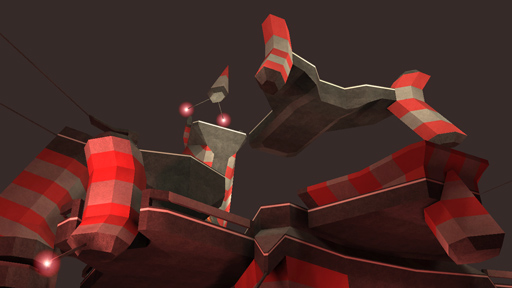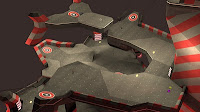- Eric Heimburg writes about selective attention / the "death-trap" device used to regulate pacing in MMORPG zones. I posted my proposed solution over there -- make the gorilla swipe at the ball. Or am I oversimplifying?
- Philip Klevestav talks about his workflow for modular props in games. I think I recognize the assets at the end from Natural Selection 2. It's important to read on art asset theory because he's basically talking about the bricks of video game levels -- and the shape / size / color of the bricks affects how we build our levels.
- Mammoth writes a manifesto of sorts for the new wave of urban design / BLDGBLOG kind of thinking -- "The future of architecture isn’t finding a worthy formal successor to modernism, post-modernism, or parametricism, it’s learning to manipulate the command line." I'm not sure if I understand it fully. Is he implying that function doesn't necessarily follow form in the real-world, by invoking the case study of One Wilshire? Or am I poor reader?
- Patrik Schumacher's (unconvincing) defense of parametricism -- unconvincing mainly because, as the commentators mention, it is ignoring the reality of materials scarcity in the future. Linking to it just in case you read over that word in the previous bullet and was wondering what the hell "parametricism" was. I know I sure did. "Huh," I thought, "so that's the name for all that weird curvy NURBs architecture everywhere."
- Stanley Fish talks about how student evaluations are poor gauges of teacher performance. I agree. When I watch playtesters, I care less about what they report and more about what they actually do. Along those lines, I have a bunch of friends in "urban studies" and they aren't really sure what it entails; maybe the problem is that they're expecting architecture when urban design isn't? Or maybe they won't know what they've learned until 10 years from now?
- Dan Reeder - "I Drink Beer"
Sunday, June 27, 2010
Sunday Papers (June 27)
(Title / idea / concept stolen from RPS, but my focus is more on architecture / education / game development stuff with an art and design emphasis.)
Thursday, June 24, 2010
Games for Windows should be banned from all computer games forever.
I realize the quality of my blog posts is rapidly plunging (I promise I'll actually write something good in the next week) but the fact that I have to spend the first 20 minutes of BioShock 2 -- not actually playing, but configuring all these stupid profiles and DRM keys -- is simply mind-numbing. Things like this are what make people militant.
If this is the way the big publishers are going, then there's never been a better time to support indie games.
If this is the way the big publishers are going, then there's never been a better time to support indie games.
Wednesday, June 23, 2010
Comment of the Month on "Handle with Care"
"the couples names are DYLAN AND JAMES are they gay? I thought i was the only one who noticed but id rather them not be gay and be two buddys or the other person was a woman u know?" [1]I realize he (?) doesn't speak for all players, but he speaks for a large number of them. Now, I don't seek to eradicate attitudes like this, as that's impossible -- people will always believe what they will -- but it is my hope that holding this opinion becomes, at the very least, extremely unfashionable. I mean, these days, it will already cost you your job.
I wonder how he'll feel about all the super homo hardcore gay pornography (that I'm now putting in, just for him; big 4096x4096 textures) in Much Madness?...
Tuesday, June 22, 2010
Exhibition: "Vida Interior" at Intermediae
Handle With Care (or should I say, "Cuidado, Frágil"?) is part of a super-way-cool-gee-whiz "alt games" exhibition (if we start calling ourselves "alt games" instead, will that bypass all the pointless debate about our label? Probably not...) called "Vida Interior" (Inner Life) at Intermediae in Madrid, Spain, alongside cool indie game devs like Dan Pinchbeck, Stephen Lavelle, the people behind Windosill and Osmos... Hurray! We're important and relevant, see? We're in a museum!
So if you happen to be in the area, go there and see it. I think there's gonna be a DJ and free booze too; or is my Spanish really that rusty? Anyway, sounds like a good time to me.
There's also some cool interviews with all the artists in the exhibition program (PDF), so check that out. (Though I'm a little disappointed by how content-less Stephen Lavelle's answers were, but I guess a lady's got to have her secrets.)
So if you happen to be in the area, go there and see it. I think there's gonna be a DJ and free booze too; or is my Spanish really that rusty? Anyway, sounds like a good time to me.
There's also some cool interviews with all the artists in the exhibition program (PDF), so check that out. (Though I'm a little disappointed by how content-less Stephen Lavelle's answers were, but I guess a lady's got to have her secrets.)
Saturday, June 19, 2010
GeoComp2: Sparth, by Nunuk
GeoComp2, put on by Nicolas "sparth" Bouvier: the purest manifestation of modernist architecture ever achieved in video games. No shaders, no normal maps, no photorealism. Just color, form and light -- sculpture. You want to understand how FPS levels work? Curious as to how artists achieved beauty without 100's of normal-mapped pipe models to clutter a level? Then look at these. Study them. Love them.
(PlanetQuake, or perhaps Gamespy, in a breathtaking display of stupidity, has deleted all its hosted sites -- including the original GeoComp2 pages. This is my attempt at ensuring these masterpieces aren't forgotten.)
Sparth, by Nunuk / "Sparth", was made before GeoComp2 I believe, but it still shares many similarities with Bengal's "Minima" -- it is an arena floater that eschews Quake 3's space gothic aesthetic in favor of an abstract style with bold colors and shapes.
Tuesday, June 15, 2010
GeoComp2: Minima, by Bengal
GeoComp2, put on by Nicolas "sparth" Bouvier: the purest manifestation of modernist architecture ever achieved in video games. No shaders, no normal maps, no photorealism. Just color, form and light -- sculpture. You want to understand how FPS levels work? Curious as to how artists achieved beauty without 100's of normal-mapped pipe models to clutter a level? Then look at these. Study them. Love them.
(PlanetQuake, or perhaps Gamespy, in a breathtaking display of stupidity, has deleted all its hosted sites -- including the original GeoComp2 pages. This is my attempt at ensuring these masterpieces aren't forgotten.)
Minima, by Bengal, was the overall winner of the GeoComp2 competition. (EDIT -- 3 May 2015: in the wake of FilePlanet's closure, I'm archiving a downloadable copy of the map .PK3 here / mirror2 ) (EDIT, 9 June 2017, fixed Dropbox link)
Tuesday, June 8, 2010
A Decision of Wasted Opportunity
Via Play This Thing comes "A Decision of Paramount Importance" by Thomas Lui. (WARNING: Some spoilers await, take 5 minutes to play it first...)
Patrick Dugan at Play This Thing already sums up some of the better features of the game -- it plays on a cool adventure game trope, the timer adds a nice touch of urgency and the art style / choice of middleware was smart. The primary weakness is how much of a binary it is, and how unrealistic the game is -- presumably the real-life situation would be much grayer than "oh my god what are all these beer cans and drugs doing here."
However, where I think this game really goes wrong is the player character.
Saturday, June 5, 2010
Interview with Game Developer Magazine
http://gamedeveloper.texterity.com/gamedeveloper/20100607?pg=55#pg55
Where I complain about the Source Engine / defend the Source Engine against its critics / talk about why playing outside is awesome and important for video game designers to do.
The "Family Dinner" game I cite in the interview isn't really fun at all. You can only play it once before everyone gets pretty pissed off about it. The funny thing is that everyone's really excited and happy at first because it sounds fun when you're explaining it. (Also, I wish I could take credit for it, but really it was a stellar final project from the first semester's students.)
Where I complain about the Source Engine / defend the Source Engine against its critics / talk about why playing outside is awesome and important for video game designers to do.
The "Family Dinner" game I cite in the interview isn't really fun at all. You can only play it once before everyone gets pretty pissed off about it. The funny thing is that everyone's really excited and happy at first because it sounds fun when you're explaining it. (Also, I wish I could take credit for it, but really it was a stellar final project from the first semester's students.)
Subscribe to:
Posts (Atom)






